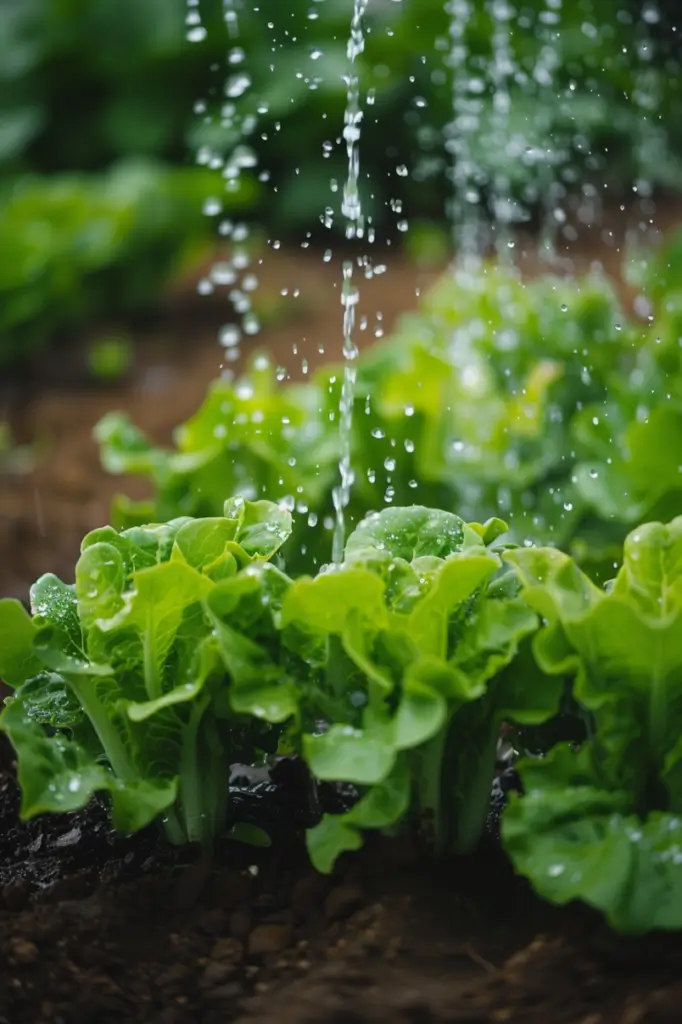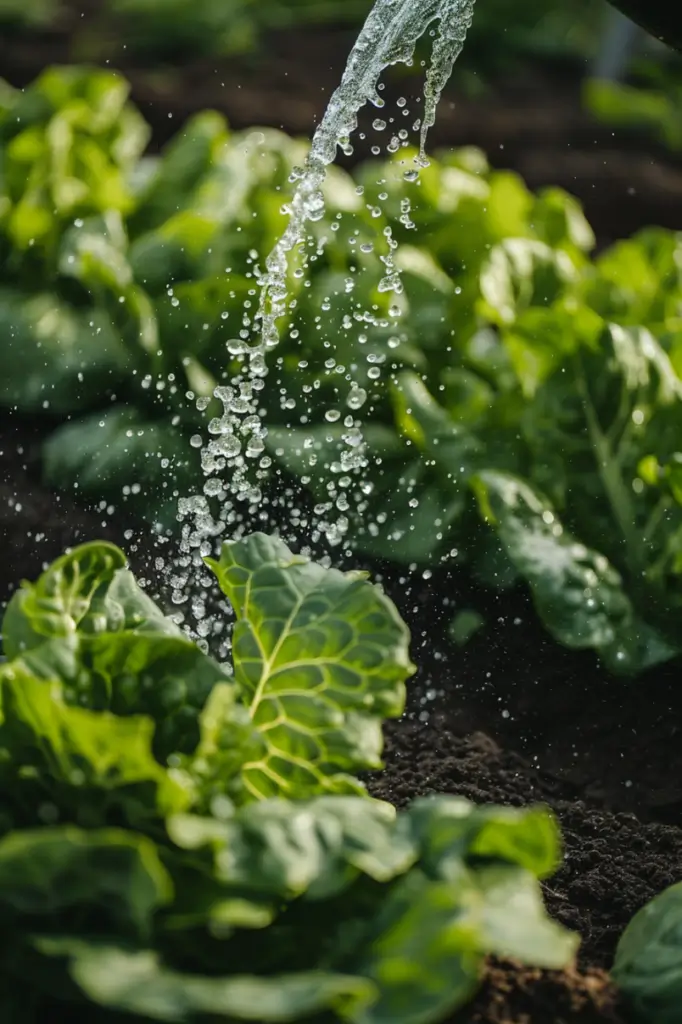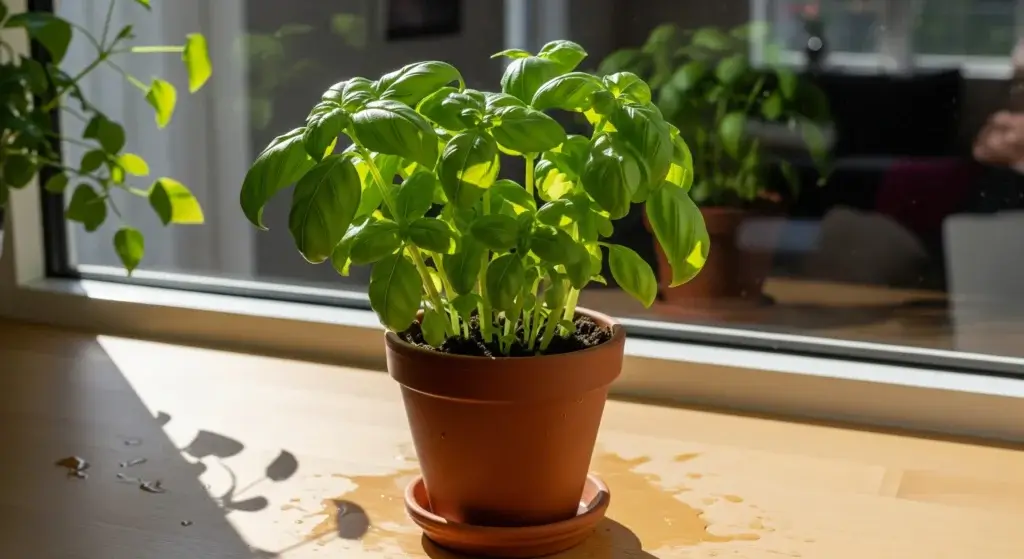
Growing lettuce at home is both rewarding and enjoyable, but ensuring your lettuce thrives requires proper care, particularly when it comes to watering.
Lettuce needs consistent moisture to grow well, but determining the right amount and frequency of watering can be challenging.
By understanding how to water your lettuce correctly, you can significantly improve your harvest.
This guide provides the essential knowledge to keep your lettuce well-hydrated and flourishing, leading to a plentiful supply of fresh, crisp salad greens.
How Much Water Does Lettuce Need
Lettuce is a relatively thirsty plant, and getting the water levels right is crucial for its growth.
On average, lettuce needs about 1 to 1.5 inches of water per week.
This can vary depending on several factors, including:
- Sunlight: Lettuce plants in full sun will need more water than those in partial shade.
- Temperature: Hotter temperatures will increase evaporation rates, so you’ll need to water your lettuce more often.
- Wind: Windy conditions can also dry out the soil more quickly.
- Rainfall: Be sure to factor in any recent rainfall when determining how much water to give your lettuce.
| Sunlight | Temperature | Watering frequency |
| High | Hot | Daily, deeply |
| Medium | Hot | Every other day, deeply |
| Low | Hot | Every 2-3 days, deeply |
| High | Mild | Every other day, deeply |
| Medium | Mild | Every 2-3 days, deeply |
| Low | Mild | Every 3-4 days, moderately |
| High | Cool | Every 3-4 days, moderately |
| Medium | Cool | Every 4-5 days, moderately |
| Low | Cool | Every 5-7 days, moderately |

Signs Your Lettuce Needs Water
Knowing when your lettuce needs water is essential to avoid over or under-watering. Here are some signs to look out for:
- Wilting leaves: One of the most obvious signs. If the leaves are drooping, it’s clear indication that your lettuce is thirsty.
- Dry soil: Stick your finger about an inch into the soil. If it feels dry, it’s time to water.
- Leaf color: Pale or yellowing leaves can also indicate a lack of water. Healthy lettuce leaves should be vibrant and firm.
- Slow growth: If your lettuce seems to be growing slower than usual, it could be due to insufficient watering.
The Best Way to Water Lettuce
There are several methods to water your lettuce, each with its own pros and cons.
Here’s a breakdown:
- Read also: Watering Lettuce in Pots: A Simple Guide for Beginners
- Read also: Caring Your Lettuce: How to Prevent Bolting in Lettuce Plants
Drip irrigation
Drip irrigation is one of the most efficient ways to water lettuce.
It delivers water directly to the base of the plant, reducing water waste and minimizing the risk of disease.
Drip systems can be automated, making them a convenient choice for busy gardeners.
Soaker hoses
Soaker hoses are another excellent option.
They slowly release water along their length, ensuring even distribution.
Place the hose close to the plants and let it do its job.
Soaker hoses are particularly useful for larger garden beds.
Hand watering
For smaller gardens or containers, hand watering with a watering can or hose can be effective.
Use a gentle spray to avoid damaging the delicate leaves.
Water at the base of the plants to keep the foliage dry, which helps prevent disease.

Watering Lettuce in the Garden
Whether you’re growing lettuce in the garden or indoors, watering techniques remain largely the same, but there are a few differences to note.
In the garden
Outdoor lettuce needs regular watering, especially during dry spells.
Early morning is the best time to water your garden lettuce.
This gives the plants time to absorb the water before the heat of the day, reducing evaporation and keeping the foliage dry overnight.
Indoors
Indoor lettuce typically requires less water than outdoor plants, as it’s not exposed to wind and intense sunlight.
However, it’s crucial to ensure that indoor lettuce still receives consistent moisture.
Containers should have good drainage to prevent waterlogging.
Using a spray bottle can help keep the soil evenly moist.
Watering Lettuce Throughout the Season
Your watering routine may need to adjust as the season progresses.
Here’s a seasonal guide:
Spring
During spring, the weather is cooler and there’s typically more rainfall.
It’s important to check the soil moisture regularly by feeling the soil with your fingers.
Water your lettuce plants as needed to keep the soil consistently moist, but avoid making it soggy.
Soggy soil can lead to root rot and other issues.
Summer
Summer brings higher temperatures and increased evaporation, which can dry out the soil quickly.
To combat this, consider mulching around your lettuce plants.
Mulch helps retain moisture in the soil and reduces the need for frequent watering.
Water your lettuce early in the morning or late in the afternoon to minimize water loss through evaporation during the hottest parts of the day.
Fall
As temperatures start to cool down in the fall, the watering needs of your lettuce plants may decrease.
Monitor the soil moisture closely and adjust your watering frequency accordingly.
Cooler weather means less evaporation, so you may not need to water as often as you did during the summer months.
Winter
In mild winter climates or if you’re growing lettuce indoors, maintain a consistent watering schedule.
Indoor environments can be drier due to heating systems, so monitor soil moisture closely and water when the top inch of soil feels dry.
For outdoor lettuce in colder regions, protect plants from frost by using row covers or cold frames.

Watering Lettuce Seeds
Seeds
When watering lettuce seeds, it’s important to handle them gently.
The goal is to keep the soil consistently moist but not overly wet until the seeds germinate.
You can achieve this by lightly misting the soil with a spray bottle.
This method helps prevent the seeds from being washed away while ensuring they have enough moisture to sprout.
Avoid using a heavy stream of water, as it can disturb the seeds or cause them to clump together.
Mature plants
Once your lettuce plants have established themselves, their watering needs change.
Deep watering becomes more effective as it encourages strong root development.
When watering mature lettuce plants, aim to water deeply enough that the moisture reaches the root zone, which is where the roots absorb water and nutrients from the soil.
- Read also: Growing Green: A Guide to Natural Pesticides for Lettuce
- Read also: DIY Plant Watering System: Keep Your Plants Hydrated
Conclusion
Watering lettuce might seem straightforward, but getting it right can be the difference between a bountiful harvest and a disappointing one.
Remember to keep the soil consistently moist, use efficient watering methods, and adjust your routine based on the season and plant growth stage.
With these tips, you’ll be well on your way to growing healthy, delicious lettuce in your garden.
FAQs
Generally, lettuce needs about 1 to 1.5 inches of water per week. This can vary based on weather and growth stage.
Yes, overwatering can lead to root rot and other diseases. Ensure the soil is moist but not waterlogged.
Early morning is ideal as it allows plants to absorb water before the day’s heat and reduces the risk of disease.
Watering at the base of the plant is best to avoid wetting the leaves, which can lead to disease.
Signs of underwatered lettuce include wilting leaves, dry soil, pale leaf color, and slow growth.



